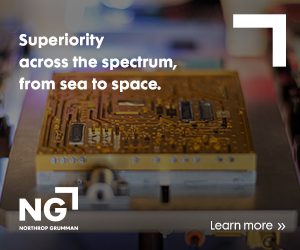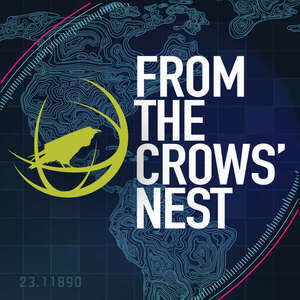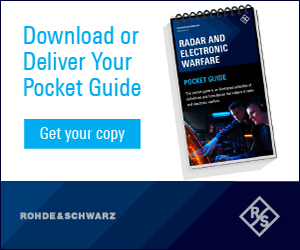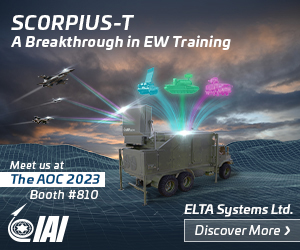 |
|||||||||||||||||||||||
| Archive | Send to a Friend | Crows.org | JED Resource Guide | WWW.JEDONLINE.COM | |||||||||||||||||||||||
|
From the Editor
AOC 2023 demonstrated the growing interest in EMSO. With more than 2,800 attendees and nearly 180 exhibitors, it was the largest AOC event in recent memory. The symposium offered leadership, operational and technical perspectives from 86 keynote speakers, panelists, presenters and session moderators who collectively addressed the theme, "Advancing EMS Superiority Through Strategic Alliances and Partnerships." Specific topics included the Russo-Ukrainian War, cognitive EW, JADC2, Electromagnetic Battle Management, open system architectures, space EW, multi-national EW partnerships and much more. In the exhibit hall, the dynamic nature of the EW and SIGINT industry was on display. Attendees could learn about new technologies and new types of EW services, from cognitive EW systems and the AI technologies that underpin their performance, to compact digital receivers and novel antenna technologies. With 34 more exhibitors than last year, small companies offering new ideas and approaches contributed significantly to the energy in the exhibit hall. Mark your calendar for next year and AOC 2024, same dates (Dec. 11-13) at the same location.
In this episode of From the Crows’ Nest, host Ken Miller is joined by Day 3 Keynote Speaker Vice Admiral Francis Morley, US Navy. Admiral Morley is the Principle Military Deputy Assistant Secretary of the Navy for Research, Development and Acquisition. They discuss the the current state of play in today’s Department of the Navy acquisition efforts, including specific areas of EW, the challenges of today and tomorrow, opportunities and our collective challenge going forward in today’s increasingly competitive world order. Ken is also joined by AOC Senior Analyst Matt Thompson for his insight into the myriad of topics discussed during the symposium this week. To learn more about AOC 2023, please visit our homepage. Symposium Happenings
Lt Gen Lance Landrum, USAF (Ret.) Discusses EW in NATO One of the Wednesday keynotes was delivered by Lt Gen Lance Landrum, USAF (Ret.), who recently retired after serving as the 23rd Deputy Chair of NATO from October 2021 through September 2023. General Landrum shared his insights on the alliance and EMSO, focusing on the current security environment, NATO adaptations to new security challenges and his recommendations on ways in which NATO EMSO could evolve. In an earlier assignment, while serving as Deputy Director for Requirement and Capability Development (J8) on the Joint Staff, General Landrum was also a deputy director of the EMSO Cross Functional Team, which developed the DOD's 2020 EMS Superiority Strategy. His knowledge of NATO, combined with his EMSO experience, provided for a very interesting keynote about NATO EW. General Landrum explained how Russia has become NATO's top security challenge beginning with its 2008 conflict in neighboring Georgia. After the disastrous beginning to its full-scale invasion of Ukraine in 2022, Russia has been learning from its mistakes and honing the effectiveness of its EW forces to help reinforce its defensive lines in eastern Ukraine over the past year. Ukraine, he said, has also learned important lessons, especially over the past summer. Its military leaders think EW is one area that can be bolstered to help restore a maneuver approach to its fight with Russian forces. General Landrum also provided an overview of the major EMS-related organizations in NATO, including the NATO Electromagnetic Warfare Advisory Committee (NEWAC), which operates under the NATO Military Committee. The NEWAC, which released a NATO EW Strategy in 2019, operates two groups: the NATO EW Working Group (NEWWG) and the NATO Emitter Database Group (NEDBAG). He also mentioned the Joint EW Core Staff (JEWCS), which is responsible for training NATO forces. "[The JEWCS], I'm very happy to report, is moving back under the NATO command structure in the coming months and years," Landrum explained. "And that is an important shift because [organizations] under the NATO command structure are eligible for common funding. That, I think, is important, because where there is money, there is priority. And where there is money, there is capability development." On the policy side, General Landrum suggested there is room for NATO to improve the way it organizes for EMS-related capabilities planning. He described the Council of National Armament Directors (CNAD), which handles acquisition among the NATO member states. He said the CNAD is organized with individual armament groups for Air, Land, and Maritime programs, with EMS matters spread across those groups. "Spectrum issues and spectrum capability and spectrum requirements are sort of taken up under those armament groups," he said. "Does that story sound familiar? Right, electromagnetic operations being sort of federated, being spread out, being "peanut butter" spread with no particular group that's focusing on it? Well, there are some challenges in the NATO headquarters right there, and that might be one of them." Having explained the organization of NATO from an EMS perspective, General Landrum then went on to discuss how EMS policy and priorities can receive greater attention within the alliance. By building on NATO's 2019 EW Strategy, he said EMS advocates within NATO can work to make EMS a policy priority and encourage member states to invest in EW programs. "First and foremost, there needs to be an influence of the political motivation and political prioritization of the spectrum," he said. "This is nothing new, right? It's the same thing that we've seen the United States. So top-down, the nation's governments in their capitals need to be motivated for the prioritization and importance and criticality of the electromagnetic spectrum and superiority in the spectrum. That's their ministries of defense, ministries of the interior, and ministries of foreign affairs. So anything anyone can do to influence those organizations, to help them understand the story of the spectrum, is going to be important." He then explained how EMS advocacy from the military officials in these nations can also help. "The bottom-up from the military side is military requirements, based on exercises, training, evaluations and things like that – so there's some data behind that. Military judgments that work from the bottom-up to meet with a political motivation, with military requirements, to say, 'Hey, listen, this is incredibly important.' And if we create that momentum, then all this bureaucracy within NATO – the working groups and the committees – start to get momentum. Some political areas to influence would be things like the comprehensive report on deterrence and defense that's worked up every year in advance of the NATO summits. If you can just get a paragraph in there, and language in there, on the importance of the spectrum and moving out and developing capabilities and superiority, then things stem from that. From the military side, including electromagnetic operations as a training discipline, including it in exercises in the training environment, making sure that it is written into the operational war plans, will be incredibly important to help define those requirements." These efforts will help to elevate EW in the NATO defense planning process, as well as the minimum capability requirements development process. However, he emphasized that the momentum for this has to come from the member nations.
Inside the Convention
Scott is a Senior Systems Architect at Lockheed Martin. He earned a BS in Electrical Engineering from Lehigh University in 2018 and then went on to earn an MS in Electrical Engineering from Johns Hopkins University. Scott's career goal is to become a chief engineer who oversees a portfolio of programs. "This will allow me to complete two ancillary professional goals," he explains. "The first is to support a program(s) through the entire engineering life cycle process from a technical position. In achieving this goal, I would get to contribute significantly to systems that make a difference for our country and its soldiers. This is one of the primary reasons that I came to work for the DOD as a contractor. The second goal is that being a chief engineer would put me in a great position to mentor up-and-coming young talent. I have been fortunate to have had numerous role models throughout my career. These role models have shared their technical expertise, shown me the correct way to lead teams, and given me growth opportunities to continue on my development path." At the company, Scott has worked on two major EW programs. The first was an airborne EW application for the US Army. The second was even more impactful. He says, "My biggest career achievement has been leading the design of a new DOD investment. This involved contributing to and leading a cross-disciplined team to design a terrestrial EW and SIGINT system from initial requirements to a compliant baseline. This achievement required cross-team communication, technical breadth and depth, and a positive attitude. I led the team in creating a unified release plan, drafting system requirements, collaborating on designing a hardware architecture and associated software architecture, and flowing all data to the Model and Simulation (M&S) team to confirm design compliance against requirements and EMS threats." You can learn more about Scott and his fellow Future 5 professionals at https://www.crows.org/page/2023Future5. For more information about the AOC's Future 5 program, please visit https://www.crows.org/page/future5.
JED News
Read the December issue of JED, hot off the presses in time for the 2023 AOC Convention: Cover Story: EW Concepts for Global Air Combat Program Read the full issue now, and read more each week at JEDOnline.com. The Journal of Electromagnetic Dominance (JED) is the official publication of the Association of Old Crows (AOC), an independent, nonprofit, international professional association promoting public understanding in the science and practice of EW, SIGINT and related disciplines. Become an AOC member to get access to the latest issue of JED.
Digital Pub Bin
Check out current issues and news from our media partners throughout the week. JED
|
|||||||||||||||||||||||









